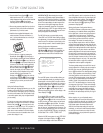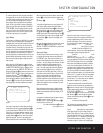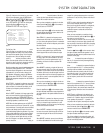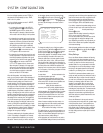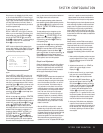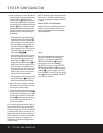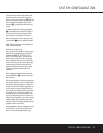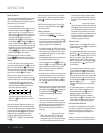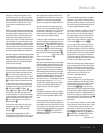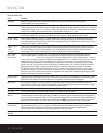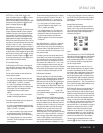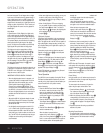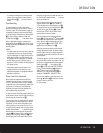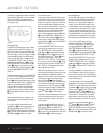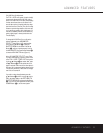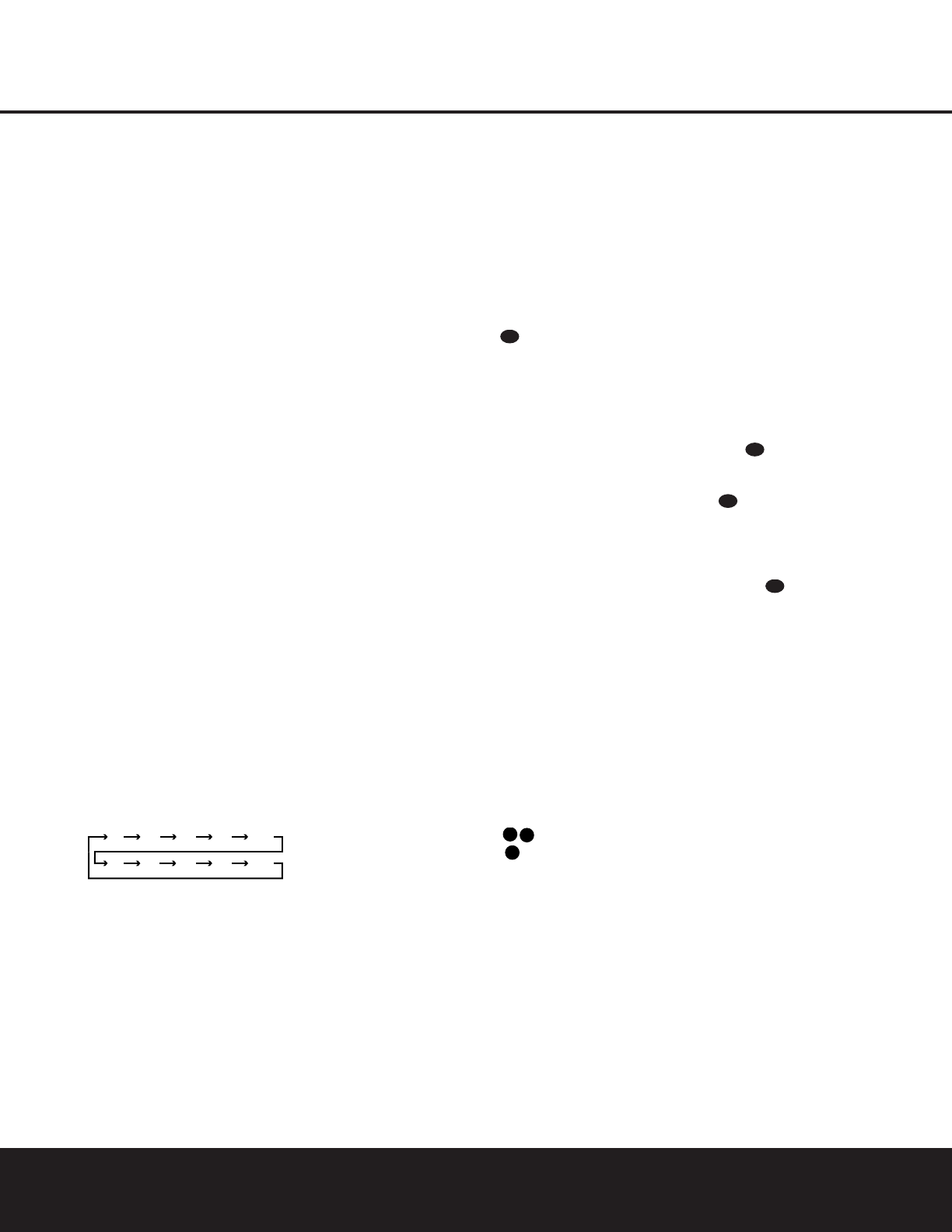
Basic Operation
Once you have completed the initial setup and configu-
ration of the AVR 230, it is simple to operate and
enjoy. The following instructions will help you maximize
the enjoyment of your new receiver:
Turning the AVR 230 On or Off
• When using the AVR 230 for the first time, you must
first press the
Main Power Switch
1
on the front
panel to turn the unit on. This places the unit in a
Standby mode, as indicated by the amber color of the
Power Indicator
2
. Once the unit is in Standby, you
may begin a listening session by pressing the
Standby/On Switch
3
on the front panel, or the
Power On Button d or AVR Selector f on the
remote. The
Power Indicator
2
will turn blue. This
will turn the unit on and return it to the input source that
was last used. The unit may also be turned on from
Standby by pressing any of the
Input Selector
Buttons
eg on the remote or the Input Source
Selector Button
^
on the front panel.
NOTE: After pressing one of the Input Selector
Buttons
eg to turn the unit on, press the AVR
Selector
f to set the remote control to the AVR 230
functions.
To turn the unit off at the end of a listening session,
simply press the
Standby/On Switch 3 on the front
panel or the
Power Off Button a on the remote.
Power will be shut off to any equipment plugged into
the rear-panel
Switched AC Accessory Outlet ‡
and the Power Indicator 2 will turn amber.
When the remote is used to turn the unit “off” it is
actually placing the system in a Standby mode, as indi-
cated by the amber color of the
Power Indicator 2.
•To program the AVR 230 for automatic turn-off,
press the
Sleep Button j on the remote. Each
press of the button will decrease the time before
shut-down in the following sequence:
The sleep time will be displayed in the
Lower
Display Line
¯ and it will count down until the
time has elapsed.
When the programmed sleep time has elapsed, the
unit will automatically turn off. The front-panel display
will dim to one-half brightness when the Sleep function
is programmed. To cancel the Sleep function,
press
and hold the
Sleep Buttonj until the information
display returns to normal brightness; the Sleep
indicator numbers will disappear and the words
SLEEP OFF will appear in the Lower Display
Line
¯
.
When you will be away from home for an extended
period of time it is always a good idea to completely
turn the unit off with the front-panel
Main Power
Switch
1
.
NOTE: All preset memories are lost if the unit is left
turned off by using the
Main Power Switch
1
for
more than four weeks.
Source Selection
•To select a source, press any of the Input
Selector Buttons
eg on the remote.
• The input source may also be changed by pressing
the front-panel
Input Source Selector Button ^.
Each press of the button will move the input
selection through the list of available inputs.
• As the input is changed, the AVR 230 will automati-
cally switch to the digital input (if selected), surround
mode, output levels and night mode status as well
as any speaker configuration or crossover settings
established by using the
INDEPENDENT
Bass Management setting, that were entered during
the configuration process for that source.
• The front-panel
Video 4 Inputs ÓÔ, Optical 3
Digital Input
*
or the Coaxial 3 Digital Input
(
may be used to connect a device such as a video
game or camcorder to your home entertainment
system on a temporary basis.
• As the input source is changed, the new input name
will appear momentarily as an on-screen display in
the lower third of the video display. The input name
will also appear in the
Upper Display Line ˜ in
the on-screen display and in the front-panel
Input
Indicators
ı.
• When an audio source is selected, the last video input
used remains routed to the
Video 1/Video 2 Video
and S-Video Outputs
gi
and Video and
S-Video Monitor Outputs b . This permits
simultaneous viewing and listening to different
sources.
6-Channel/8-Channel Direct Input
• There are two input choices available for use with
sources such as a DVD-Audio or SACD player that
are connected to the
6/8-Channel Direct Inputs
j. Select the appropriate input according to
the way your system and source equipment are
configured:
■ 6CHDIRECT should be used when the
SBR and SBL inputs are NOT in use and the
input source device has its own internal bass
management system. This input passes the input
from the source directly through to the volume
control without any analog to digital conversion
and it mutes the unused input jacks to prevent
unwanted noise from interfering with system per-
formance.
■ 8CHDIRECT should be used when an
input is connected to all eight
8-Channel Direct
Inputs
j and when the input source device has
its own internal bass management system. This
input passes the input from the source directly
through to the volume control without any analog-
to-digital conversion and it mutes the unused
input jacks to prevent unwanted noise from
interfering with system performance.
Volume Control
• Adjust the volume to a comfortable level using the
front-panel
Volume Control Ù or remote Volume
Up/Down Buttons
.
• To temporarily silence all speaker outputs, press the
Mute Button . This will interrupt the output to
all speakers and the headphone jack, but it will not
affect any recording or dubbing that may be in
progress. When the system is muted, the word
MUTE will flash in the Lower Display Line ¯.
Press the
Mute Button again to return to
normal operation.
• You may adjust the bass and treble tone controls
at any point during a listening session by simply
turning the
Bass Control or Treble Control
Ú until the desired setting is achieved. You may
also totally remove the tone controls from the circuit
so that the output is “flat” at any time by pressing
the
Tone Mode Button 5 and then pressing the
‹/› Button ) so that TONE OFF appears
in the on-screen display and the
Lower Display
Line
¯ .
• For private listening, plug the 1/4" stereo phone
plug from a pair of stereo headphones into the
front-panel
Headphone Jack
4
. When the
headphone’s plug is connected, the word
HEADPHONE will scroll once across the
Lower Display Line ¯ and all speakers will be
silenced. When the headphone plug is removed,
the audio feed to the speakers will be restored.
Surround Mode Selection
One of the most important features of the AVR 230
is its ability to reproduce a full multichannel surround
sound field from digital sources, analog matrix
surround-encoded programs and standard stereo
programs.
Selection of a surround mode is based on personal
taste, as well as the type of program source material
42
42
38
31
36
34
41
90
min
80
min
70
min
60
min
50
min
40
min
30
min
20
min
10
min
OFF
OPERATION
24 OPERATION



